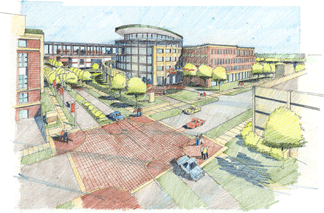 The University of Nebraska Board of Regents Saturday approved a program statement for the Center for Health Science Education at UNMC.
The University of Nebraska Board of Regents Saturday approved a program statement for the Center for Health Science Education at UNMC.
“We are grateful to the Regents for their support on this project,” UNMC Chancellor Harold M. Maurer, M.D., said. “This building will allow us to remain at the forefront nationally, in terms of educating our students.”
The 131,296-square-foot Center for Health Science Education will be located at the northeastern corner of 42nd Street and Emile Streets. It will be home to the UNMC College of Medicine. No state tax dollars will be used for construction of the building.
In all, the Center for Health Science Education will cost $52.7 million. That amount includes: construction of the new center; the demolition of properties currently on the site; the relocation of departments and units currently there; construction of a greenway along Emile Street from 42nd Street to 40th Street; the remodeling of 12,500 square feet of space in Wittson Hall, the current home of the College of Medicine; and the construction of a sky bridge across 42nd Street, from the new building to Wittson and Bennett Halls.
The Center for Health Science Education will replace obsolete and insufficient facilities with state-of-the-art classrooms and class laboratories, including a clinical skills learning and assessment facility and small-group instruction rooms.
UNMC officials will select an architect/engineer for the project in January 2004. The earliest possible completion for the project would be October 2006. Many of the employees in the current Computing Services building and in the 41st Street annexes would be relocated, but the earliest that the relocation would take place is April 2005.
Most of the IT employees would be relocated to about 35,000 square feet of presently vacant space in the 4230 Building. The balance of the IT employees, the Physicians Assistant Program faculty and the Chemical & Radiation Safety organization would be relocated into vacated space in Poynter and Bennett Halls. That space is currently occupied by researchers whose labs will move into the Durham Research Center. Specific relocation sites will be determined during the design phase of the project, which could be completed in summer 2004, at the earliest.